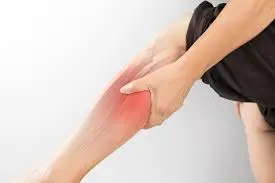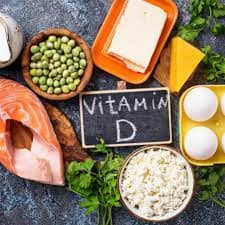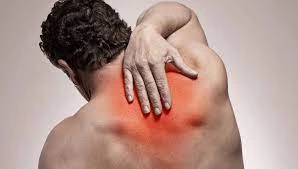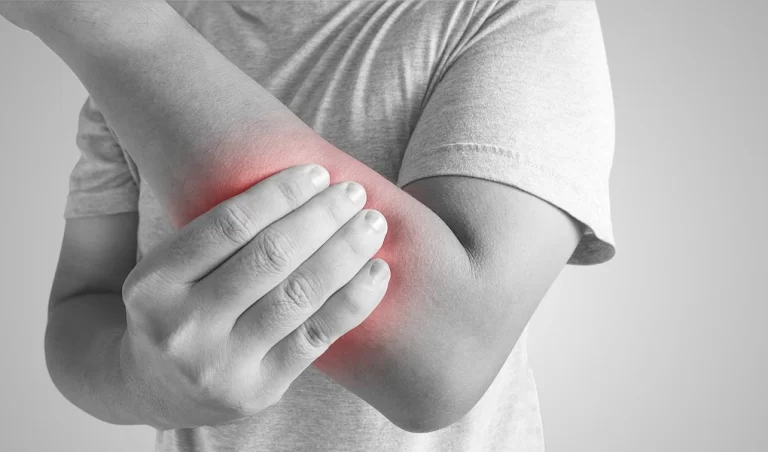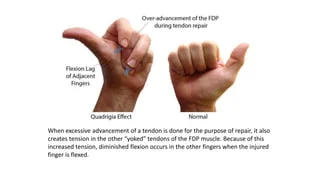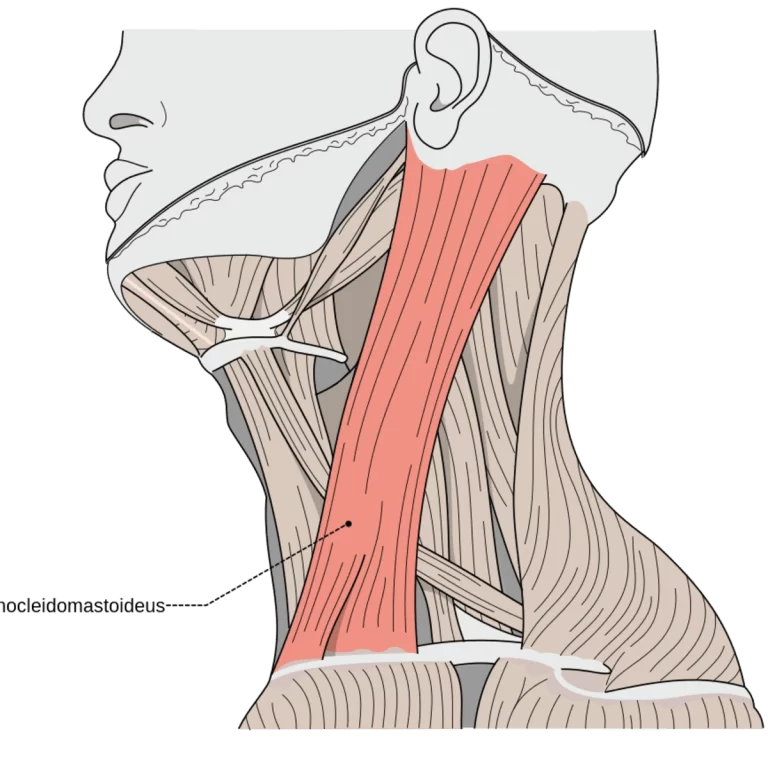Muscle Knots In Calf Muscle
What is a Muscle Knot in Calf Muscle?
Muscle knots, also known as myofascial trigger points, are localized areas of muscle tightness and tension that can cause discomfort and pain. These knots can develop in various muscles throughout the body, and one common location for their occurrence is in the calf muscles. The calf muscles, comprising the gastrocnemius and soleus muscles, are essential for activities such as walking, running, and jumping.
Muscle knots in the calf can result from a variety of factors, including overuse, muscle imbalances, inadequate stretching, or prolonged periods of inactivity. These knots may feel like small, palpable nodules within the muscle tissue and can lead to symptoms such as pain, stiffness, and restricted range of motion.
Understanding the causes, symptoms, and effective treatment options for muscle knots in the calf is crucial for managing discomfort and preventing further complications. In this exploration, we will delve into the nature of muscle knots in the calf muscles, examining their potential causes, symptoms, and potential strategies for prevention and relief.
Overview
Our muscles are designed to be supple, robust, and demanding. However, we can lose our mobility and flexibility if we sit at a computer all day in the same position, if we injure ourselves, or if we are chronically dehydrated. The muscle fibers adhere and form a hard, lumpy knot.
Muscle ‘knots’ are extremely frequent, however, this does not imply that they are normal or innocuous. Chronic muscle stress causes micro-tearing of muscle tissue, which results in scar tissue. Unfortunately, if the muscle tissue is not addressed, it will continue to lose flexibility and generate postural stress that is difficult to reverse. It’s not all bad news, though, because there are many things you can do to alleviate and avoid muscle knots.
Types of muscle knots
Muscle knots can be active or latent, according to medical professionals. When pressed or touched, a latent myofascial trigger point (knot) becomes painful. Active trigger points, on the other hand, create persistent discomfort with dull throbbing. Active knots make mobility difficult and cause significant pain.
WHERE DO MUSCLE KNOTS DEVELOP?
Knots tend to develop in heavily stressed muscular regions.
Lower legs
Neck
Shoulders
Shins
Lower back
WHY DO KNOTS EXIST IN CALF MUSCLES?
Calf knots are muscles that are too tight and inflexible to relax and soften. They limit movement and reduce quality of life.
Muscle knots in the back, neck, and shoulders, on the other hand, are more common. Calf muscles are not immune to this ailment. Knots can form anywhere in the human body that has muscle and fascia, and calves have both. These knots form when calf muscles are either overworked or get shortened as a result of sitting for lengthy periods of time, leaving your legs with little room to move.
CAN CALF KNOTS BE PAINLESS?
Latent knots are painless as long as they are dormant and not pressed. Calf muscle knots can exist for a long period without being noticed. However, they can be activated at any time and without notice, producing extreme agony.
IS A CALF KNOT VISIBLE?
The word “knot” conjures up images of a hard hump or a protrusion on the skin’s surface. Calf muscle knots are not obvious lumps, but rather tight bands of muscle that are not visible to the human eye.
CAUSES OF MUSCLE KNOTS
SEDENTARY LIFESTYLE
Muscle fibers have the ability to lengthen and shorten as well as contract and relax. Nevertheless, these muscle fibers have a tendency to stick together and form a knot if we spend our entire day at our computers with little to no exercise. Additionally, poor posture strains the muscles, which over time may result in the formation of scar tissue.
PSYCHOLOGICAL STRESS
The human body is well-prepared to deal with stressful situations. However, there are times when the levels of stress exceed the human capacity to withstand. This has a negative impact on both the mind and the body. One such unfavorable impact is the production of knots in the calves and other muscles.
Psychological stress can cause the musculoskeletal system to react, resulting in muscle tightness as the most common reflex action. These tense muscles tend to stay contracted until the source of the stress fades, but chronic stress can prevent the muscles from releasing tension, leading to the formation of muscular knots. It’s worth noting that mental tension, despite its peculiar nature, can also affect the calves.
OSTEOARTHRITIS (JOINT PAIN)
Osteoarthritis is a degenerative joint disease in which joint tissue begins to deteriorate. This disorder makes people more prone to the formation of muscle knots.
SLEEP DISTURBANCES
According to the London Pain Clinic, 60% of people suffer from sleep difficulties. Surprisingly, sleep difficulties are a primary cause of knots and myofascial trigger points. Muscle weariness results from a lack of sleep. If this continues, knots form because muscles are unable to totally relax during quality sleep. Exhausted muscles, on the other hand, generate aches and pains that keep you awake and unable to sleep.
POOR ERGONOMICS
Muscle knots are usually caused by prolonged sitting, working long hours, and stressful job conditions. The Center for Knee and Hip Care’s Senior Transplant Head for Hip and Knee Joint Replacement discusses the impact of poor ergonomics:
The development of muscle knots is a major risk factor for corporate and working professionals because of their demanding schedules and long workdays.
When your calves are immobile and tight, the fibers that make up your calf muscles bind together and shorten in length, resulting in knot development.
BAD POSTURE
Knots form in the calves as a result of confined and compact workstations. Because there is little room to flex your muscles in tiny settings, your legs become constricted. Calf muscle knots form as a result of your body’s posture being disturbed, specific muscle groups being overused, and some muscles being tight and dormant.
RISK FACTORS
AGE
Even if you exercise consistently, age causes muscle inflexibility. Calf muscles grow more stiff and prone to knotting as you get older.
FIBROMYALGIA
Sometimes your body aches all over for no apparent reason. Your blood tests are negative, and nothing appears to be visible on your MRIs and CT scans. Fibromyalgia is an unexplained disorder characterized by chronic pain and aching muscles. The brains of fibromyalgia patients are more receptive to pain sensations. When muscles are constantly bombarded with pain signals, they might form myofascial trigger points or knots in reaction to the internal stimuli.
CHRONIC STRESS & ANXIETY
Calf muscle knots are more likely to arise if you live a stressed lifestyle. As a defense mechanism, stress causes muscles to tense. Myofascial trigger points or knots form in the calf muscles if the muscles remain strained. Reduce your stress and anxiety levels. To relieve stress in your calf muscles, meditate or attend therapy sessions.
DIAGNOSIS OF MUSCLE KNOTS
- Sore spots in the muscles are not visible, but they are felt.
- When you touch these aching spots, the surrounding muscles will feel tight and overstretched.
- You have a nagging soreness in your lower leg (sharp or dull). The knots may be on one side of the calf, but the agony is felt throughout.
- The pain is limited to the flesh (calf muscle), not the shin bone or knee joint.
- Strenuous exercise or exertion will aggravate the pain.
- Muscles are fatigued and feeble. Even the tiniest movements are taxing.
ARE CALF MUSCLE KNOTS AND LUMPS SIMILAR?
There is a distinction to be made between a lump and a knot. When you press deeply into the connective tissues, calf muscle knots will feel like hard lumps, but they are not lumps.
Lumps in the muscle are soft tissue growths that are visible on the skin and can be benign or cancerous.
TREATMENT OF MUSCLE KNOTS IN CALF MUSCLE
ACUPUNCTURE
A small, microscopic needle is used in the acupuncture treatment to release the trigger point. The acupuncturist will locate the source of the pain. The needle will then be inserted into the afflicted calf muscle to relieve the trigger point. The muscle will now stretch and lengthen.
Because the piercing needle does not produce muscle rips, which may take longer to heal, this procedure is by far the safest and least painful.
DRY-NEEDLING
Dry needling is a new technique for treating calf muscle knots. The practitioner will place multiple filiform needles, which are small, fine stainless steel needles, into the trigger points. The technique is known as “dry needling” because the needles introduce no fluid into the muscles.
ELECTROSTIMULATION
Transcutaneous electrical nerve stimulation (TENS) units are used to treat calf muscle knots and the pain that comes with them. A TENS machine modulates pain impulses, resulting in pain relief and endorphin release. Tight muscles begin to relax as the pain subsides.
The TENS unit’s electrode pads are placed over the afflicted area. The equipment will cause the calf muscles to contract automatically. They will begin to relax on their own, and the knots will soften.
CHIROPRACTIC TREATMENT
Calf muscle knots can develop as a result of joint dysfunction and limitations. Hands-on chiropractic manipulation of the muscles by the chiropractor relieves these constraints. Once the constraints have been effectively removed, the knots are removed.
ULTRASOUND THERAPY
The effectiveness of ultrasound therapy to treat myofascial trigger points is comparable to invasive needle penetration methods.
The treatment is identical to having a regular ultrasound. The machine’s transducer probe is put on the affected calf area. Depending on the patient’s health, a chilly, medicinal gel is also applied. Vibrations are transmitted into the body via the skin via the probe. The ultrasound waves cause the tight knots in the connective tissues to vibrate and relax.
LASER THERAPY
Low and high-power laser therapy is the most effective method of treating muscular knots and relieving pain associated with them. In the “knotted” areas, laser therapy encourages the generation and release of pain-relieving molecules. Furthermore, laser therapy sends photon energy into the cells. There is no heat damage since the energy is absorbed by the skin and tissues via a photochemical process.
Physiotherapy exercises
Calf raises
Begin by standing with the feet hip-width apart and the core engaged. Slowly raise the body, elevating the heels till you’re on your toes while squeezing your calf muscles. Stand tall and straight before lowering your heels to the floor with control. Repeat.
Jumping jacks
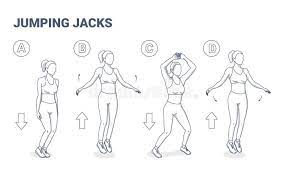
Begin by standing upright, legs together, and arms by your sides. Jump into the air with your knees slightly bent. Spread your knees shoulder-width apart and swing your arms laterally up and over your head as you jump. Return to your starting location and repeat!
Butt kickers
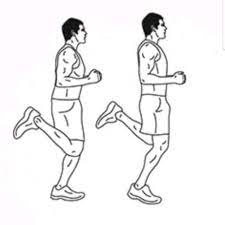
Start with your feet hip-width apart while standing. To help with hip flexor mobility and to loosen up your quadriceps, you’ll be kicking your feet behind you in an attempt to contact your butt. You just need to kick your left foot back toward your left glute after kicking your right foot toward your right glute. You could feel like you’re jogging in place the faster you move, so concentrate on kicking your feet toward your glute with each stride.
Jump squat
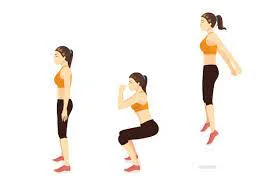
A powerful exercise that works your entire lower body and core is jump squats. Make a low squat with your feet hip-distance apart. Maintain a straight and sturdy back, and place your knees behind your toes. Leap straight up and raise your arms aloft with control. Return to your starting position gently, then repeat.
Raised heel squat
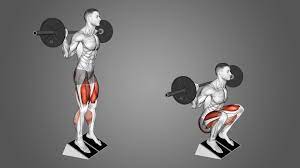
Start in a plank posture, maintaining a straight back, low hips, and an active core. Approach your right elbow with your right leg under your chest. Put your left leg under your chest and towards your left elbow, then bring your right leg back to the plank position. Maintain a steady speed as you repeat, switching up your legs. Breathe, of course, and focus on using your hamstrings, glutes, and core.
Mountain climbers
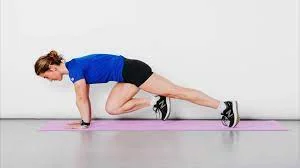
Place your toes slightly outward while keeping your feet shoulder-width apart. Lift your heels off the ground gradually while maintaining your stability with your core engaged. To avoid knee pain or injury, keep your knees soft but straight during this exercise. After a little moment of holding at the peak, carefully return your heels to the ground. Repeat.
Inward calf raise
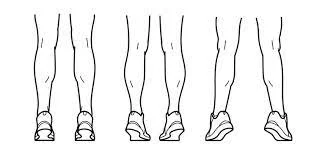
Once more, place your feet shoulder-width apart and turn your toes slightly inward. Lift your heels off the ground gradually while maintaining your stability with your core engaged. To avoid knee pain or injury, keep your knees soft but straight during this exercise. After a little moment of holding at the peak, carefully return your heels to the ground. Repeat.
Isometric calf raise exercise

We will start with a standard calf lift for this exercise. Squeeze your calves while lifting your heels off the ground while maintaining a tight core. Stop when you’ve completed the motion. Take a deep breath here, hold it for three counts, and then release the breath to return to the starting position. Repeat.
Fast feet
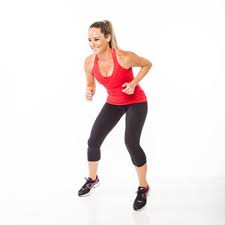
We’ll begin this workout in an athletic half-squat position. Maintain a shoulder-width distance between your feet, a low hip, and loose or slightly bent knees. Run as fast as you can while pushing into the balls of your feet. Swing your arms forward and backward for additional speed and stability.
Reverse lunge
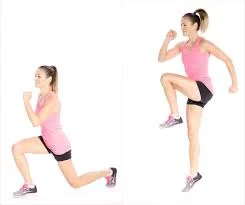
With your feet hip-distance apart, stand up straight and stride back with your right foot. Next, without touching the floor, lower your right knee to the floor while driving your left hip back. After that, drive off your right foot to get back to where you were before. Repeat, using the left foot to take a step back this time. Proceed to alternate legs, finishing ten reps for each leg.
Seated calf raise
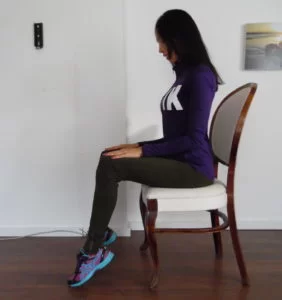
With your feet comfortably flat on the ground, take a seat in a chair. As you can, bring your heels up to your toes and then slowly lower them back to the beginning position. Ten repetitions should be made.
Walking lunge
Place your feet hip-distance apart as you begin standing. Take a long stride forward with your right foot while keeping your body erect and your core active. As you lower yourself into a lunge position, contract your core. Lower your back knee to the ground while bending both knees; do not touch the ground. Push yourself back up to a standing position while maintaining the weight on your right foot. On the other leg, repeat. Perform ten reps for each leg.
Tiptoe walk
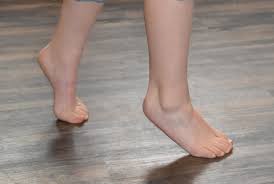
The calves’ general strength and balance will both be enhanced by this workout. Lift both heels off the ground and stand up to the tips of your toes. Take quick steps forward. For thirty seconds, keep going. After a brief break, repeat twice more.
Lunge jumps

Assume a lunge by widening your stance and placing one foot in front of the other while standing. Use your core muscles to propel yourself upward as you lower yourself into the lunge. When you land, quickly switch feet to get into a new lunge position. Make every effort to land gently. Avoid locking your knees. Do ten repetitions total, five on each leg.
Seal jumps
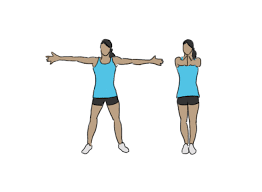
Start in the jumping jack position for this variant of the exercise. Your hands will stretch out in front of you when you jump rather than over your head. As your hands come together, keep them at eye level with your palms facing each other. Go back to where you were before. Ten repetitions should be made.
High knees
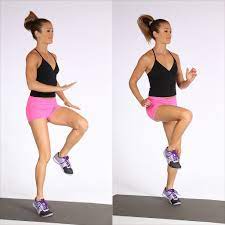
Place your arms by your sides and your feet hip-width apart as you stand. Using your core, drive one knee up to a 90-degree angle while pumping the opposing arm to shoulder height. In order to repeat the move, quickly switch legs. To quickly shift and activate your calves, continue to land on the balls of your feet. Do twenty repetitions, ten on each leg.
Calf rocks
Ensure that your feet are shoulder-width apart. Before you shift your weight onto your heels and lift your toes off the floor, contract your abdomen. With your heels off the ground, rock forward to stand up on your toes. This is the only time it has happened. Ten repetitions should be made.
Lunges
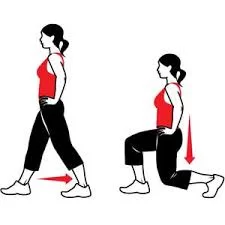
- In a standing position, spread your feet shoulder-width apart.
- Squeeze your glutes, and shoulder blades, and glance straight ahead of you while maintaining a neutral gaze.
- Lunges can be done with just your body weight or various tools, such as kettlebells, dumbbells, or barbells held in various configurations.
- To keep things simple, begin by grasping two dumbbells at hip height, one in each hand.
- With one leg, take a small step forward and land on your heel. Strive to keep your knee from hitting the floor.
- Maintain an erect posture with your chest while bending your knees to create a straight angle with your legs.
- Activate your frontal deltoids to support knee protection.
- To return to the beginning position, drive your front heel off the ground. Squeeze your core to maintain balance and keep your torso firmly erect.
- Complete three sets of eight to ten repetitions for each leg, or work for five minutes at a rate of 45 seconds on, 15 seconds off.
Squats
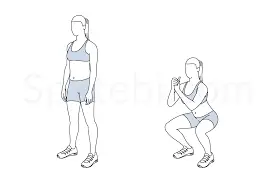
- Toes pointing forward, position your feet slightly wider than your hip breadth.
- Push your knees slightly open and bend at the ankles and knees as you drive your hips back.
- Maintaining your heels and toes on the ground, your shoulders back, and your chest elevated, assume a squat stance.
- Eventually, aim to achieve parallel, which is a 90-degree bend in the knees.
- To get back to an upright standing position, straighten your legs and apply pressure to your heels.
PREVENTION OF MUSCLE KNOTS
Knots can be tenacious and practically impossible to avoid. However, you can begin caring for your muscles by concentrating on the following aspects:
POSTURE
Your slogan when sitting at your work should be “Slouching is prohibited.” When a person is immersed in their task, it is easy to lose sight of their body posture and the amount of stress on their muscles. Sit with your back straight and your body relaxed, avoiding crossing your legs which puts tension on your calves.
EXERCISE
If your employment demands you to sit for extended periods of time, you are already spending too much time in a chair. During your non-working hours, try to combine more standing, walking, exercising, and relaxing activities.
MINERAL INTAKE
To operate effectively, muscles require calcium, magnesium, and potassium ions. You should be evaluated for deficiency, but if you are not, continue to consume minerals in healthy, balanced levels.
GENTLE SELF MASSAGE
Calf muscle knots can be relieved with a massage. Every day, for a maximum of 10 minutes, massage the trigger points in your calves. Excessive massaging of a specific area might aggravate muscular irritation.
FAQ
What causes my leg muscles to bulge?
Numerous conditions can result in soft tissue masses in the calf, including myositis ossificans, deep vein thrombosis (DVT), Baker’s cyst, pseudo thrombophlebitis, benign or malignant tumors, muscle spasms, muscle contusions or hematomas, and myositis ossificans.
What is the calf muscle knot’s trigger point?
Trigger Points of the Gastrocnemius: The Points That Trigger Calf Cramps…
The medial head of the gastrocnemius contains the two medial trigger points: the lower trigger point is located an inch or two below the knee crease, while the higher trigger point is located just below it.
What’s the duration of calf knots?
Muscles require time to heal from tension or adjust to a new motion. Muscle knots usually go away on their own in a week or two. You can expedite the healing process as well.
With a calf knot, are you able to run?
Running should be avoided during the early phase when your calf will likely become sore and rigid. If riding a bike or going to the pool doesn’t hurt your calf, then go for it.
REFERENCES
- Athletico. (2021, December 6). What Is A ‘Muscle Knot’ And How To Treat It. Athletico. https://www.athletico.com/2014/05/01/what-is-a-muscle-knot/
- Calf muscle knots – all you need to know about these painful lumps! (2022, August 17). Born Tough. https://www.borntough.com/blogs/news/calf-muscle-knots-all-you-need-to-know-about-these-painful-lumps
- I’m a personal trainer and I am begging you not to skip your calves on leg day. (2023b, February 10). TODAY.com. https://www.today.com/health/diet-fitness/best-calf-exercises-rcna17221
- Neumann, K. D., & Seaver, M. (2023, March 8). Here’s How to Do Squats Properly, Safely, and Effectively Every Time. Real Simple. https://www.realsimple.com/health/fitness-exercise/workouts/squat-form
- Nasm, B. W., & CSCS, E. S. (2023, March 15). How to do a lunge the right way. Men’s Health. https://www.menshealth.com/fitness/a28195034/lunges-exercise/

